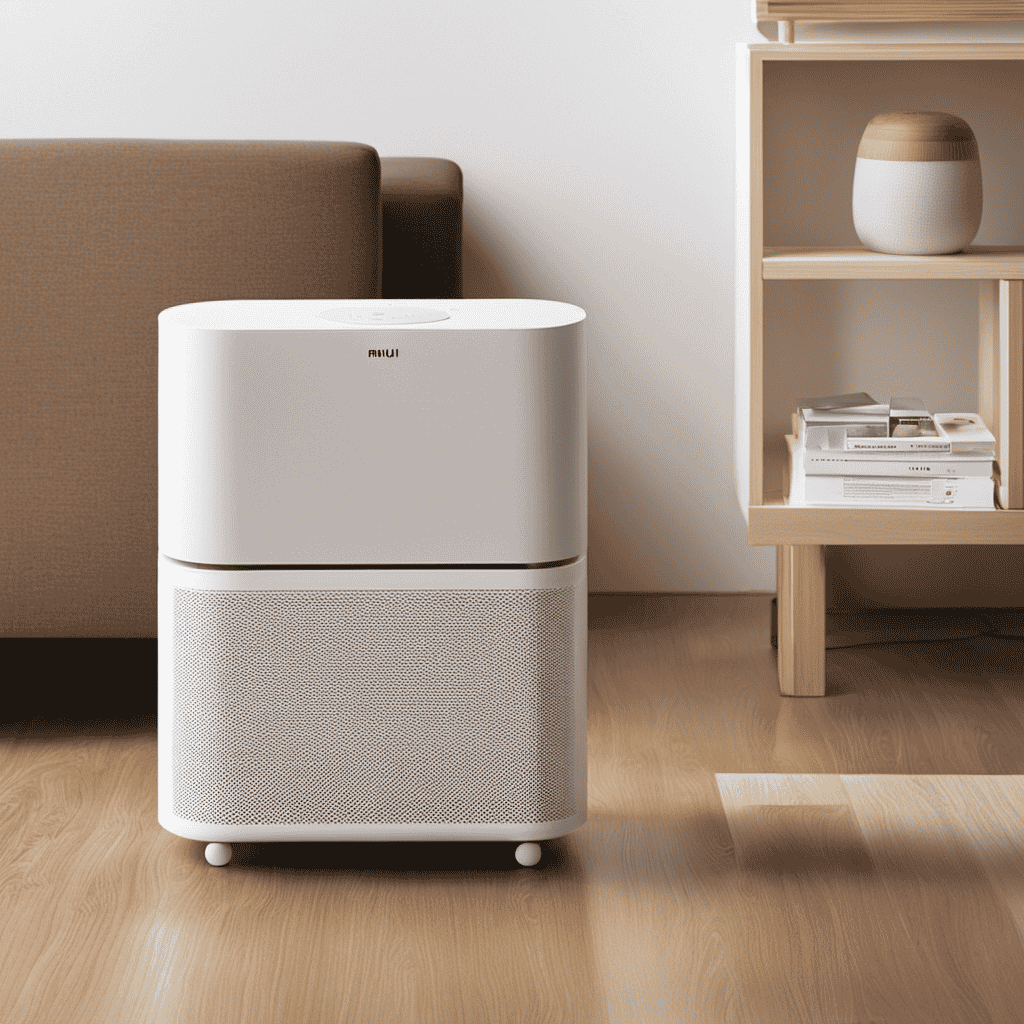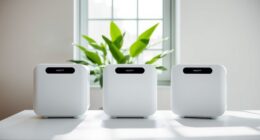As a fan of air purification, I am constantly looking for ways to enhance the performance of my air purifier. This is why knowing how to calculate the CADR (Clean Air Delivery Rate) is essential.
CADR not only helps determine the effectiveness of an air purifier, but also ensures that it is suitable for your room size.
In this article, I’ll guide you through the step-by-step process of calculating CADR, avoiding common mistakes, and comparing CADR ratings.
Get ready to breathe cleaner, fresher air with the right CADR level.
Key Takeaways
- CADR stands for Clean Air Delivery Rate and measures the amount of clean air delivered by an air purifier in a specific time.
- CADR determines the effectiveness of an air purifier in removing pollutants and helps in choosing the right air purifier for the room size.
- Choosing the right CADR is important for efficient air purification, considering factors like room size, placement, and filter maintenance.
- Regularly cleaning or replacing filters is essential to maximize air purification and optimize the performance of an air purifier.
Understanding CADR for Air Purifiers
To understand CADR for air purifiers, you’ll need to know how it is calculated and what it means for the effectiveness of the device.
CADR stands for Clean Air Delivery Rate, and it measures the amount of clean air that an air purifier can deliver in a specific amount of time. CADR calculation methods vary, but they generally involve measuring the amount of particles removed from the air by the purifier. These particles can include dust, pollen, and smoke.
CADR standards and regulations ensure that air purifiers meet certain performance levels. These standards are set by organizations like the Association of Home Appliance Manufacturers (AHAM) and the American National Standards Institute (ANSI).
Understanding CADR and the methods used to calculate it can help you choose the right air purifier for your needs.
The Importance of CADR in Air Purification
When it comes to air purification, understanding the CADR (Clean Air Delivery Rate) is crucial. The CADR is a measure of how effectively an air purifier can remove pollutants from the air.
Choosing the right CADR for your specific needs is important, as it determines the size of the room the air purifier can effectively clean.
Additionally, maximizing air purification involves considering factors such as room size, air purifier placement, and filter maintenance to ensure optimal performance and clean air quality.
CADR and Air Quality
The CADR of an air purifier is a measure of its ability to improve air quality. It is an important factor to consider when choosing an air purifier for your home or office. Here are three ways in which CADR can impact your health and energy consumption:
-
Health benefits: A higher CADR indicates that the air purifier can remove more pollutants from the air, such as dust, pollen, and pet dander. This leads to cleaner and healthier air, reducing the risk of respiratory issues and allergies.
-
Energy consumption: Air purifiers with higher CADR ratings generally have more powerful fans and filters, which can consume more energy. However, their efficiency in removing pollutants means that they can clean the air faster, allowing you to run them for shorter periods and save energy in the long run.
-
Choosing the right CADR: It is important to consider the size of the room when selecting an air purifier. A CADR that is too low for the room size may not provide sufficient air purification, while a CADR that is too high may be unnecessary and inefficient in terms of energy consumption.
Choosing the Right CADR
Consider the size of your room when selecting an air purifier with the right CADR to ensure optimal air purification. The Clean Air Delivery Rate (CADR) is a measure of an air purifier’s efficiency in removing pollutants from the air. It indicates the volume of clean air that an air purifier can deliver per minute.
To find the optimal CADR for your room, you need to consider the size and the specific air quality concerns you have. A larger room requires a higher CADR to effectively clean the air. If you have allergies or asthma, you may need a higher CADR to remove allergens and irritants.
Look for an air purifier with a CADR that matches your room size and addresses your specific concerns for the most efficient air purification.
Maximizing Air Purification
To get the most out of your air purifier, make sure to regularly clean or replace the filters. This is crucial for improving performance and optimizing filtration.
Here are three steps to help you maximize air purification:
-
Clean the pre-filter: The pre-filter captures large particles like dust and hair. Regularly vacuum or wash it to prevent clogging and maintain optimal airflow.
-
Replace the HEPA filter: The HEPA filter removes small particles like pollen and pet dander. It should be replaced every 6-12 months, depending on usage. Check the manufacturer’s instructions for specific recommendations.
-
Clean the carbon filter: The carbon filter absorbs odors and chemicals. Clean it by vacuuming or gently washing it to remove accumulated debris and maintain its effectiveness.
Key Factors in Calculating CADR for Air Purifiers
When it comes to calculating CADR for air purifiers, there are several key factors to consider.
First, the accuracy of CADR measurements is crucial in determining the effectiveness of an air purifier. It is important to understand the methodology and standards used in measuring CADR to ensure accurate results.
Secondly, the type of filter used in the air purifier can have a significant impact on its CADR rating. Different filter types have varying capabilities in removing pollutants from the air, so it is essential to choose a filter that suits your specific needs.
Lastly, the size of the room where the air purifier will be used is another important consideration. The CADR rating of an air purifier should be appropriate for the room size to ensure efficient air purification.
CADR Measurement Accuracy
The accuracy of CADR measurements can be affected by various factors, such as the size of the testing room. To ensure accurate CADR measurements, it’s important to follow standardized testing methods and adhere to specific testing standards.
Here are three key factors that can impact CADR measurement accuracy:
-
Room Size: The size of the testing room can greatly influence CADR measurements. A larger room may dilute the concentration of pollutants, resulting in lower CADR values. On the other hand, a smaller room may have higher pollutant concentrations, leading to higher CADR values.
-
Test Conditions: It’s crucial to maintain consistent test conditions, including temperature, humidity, and airflow, to obtain accurate CADR measurements. Any deviations in these conditions can affect the performance of the air purifier and may result in inaccurate CADR readings.
-
Testing Equipment: The quality and calibration of the testing equipment used can also impact CADR measurement accuracy. It’s important to use reliable and properly calibrated instruments to ensure precise and consistent measurements.
Impact of Filter Type
You can enhance the effectiveness of your air purifier by considering the impact of different filter types.
The filter type you choose for your air purifier can greatly affect its ability to remove pollutants from the air. HEPA filters, for example, are known for their high efficiency in capturing airborne particles as small as 0.3 microns. They are highly effective in removing allergens, dust, and pet dander.
Activated carbon filters, on the other hand, are effective in removing odors, smoke, and chemicals from the air. They work by adsorbing these pollutants onto their porous surface.
Combination filters, which combine both HEPA and activated carbon filtration, offer a comprehensive solution for improving indoor air quality.
Room Size Considerations
When it comes to choosing an air purifier, one of the key considerations is the size of the room you want to purify. The room size plays a crucial role in determining the Clean Air Delivery Rate (CADR) required for effective air purification.
Here are three factors to consider when determining the appropriate CADR for your air purifier:
-
Room dimensions: The square footage of the room is an important factor in calculating the CADR. A larger room will require a higher CADR to ensure proper air circulation and purification.
-
Pollutant level: The level of pollutants in the room will also influence the CADR needed. If the room is heavily polluted, such as in a smoking area or near a busy road, a higher CADR will be necessary to effectively remove the pollutants.
-
Occupancy: The number of people occupying the room can affect the CADR requirements. More people means more pollutants being generated, so a higher CADR may be needed.
Considering these factors will help you determine the appropriate CADR for your air purifier.
Now, let’s move on to the step-by-step guide to calculate CADR for your air purifier.
Step-by-Step Guide to Calculate CADR for Your Air Purifier
Start by gathering the necessary information for calculating CADR for your air purifier.
To calculate CADR for large spaces, you need to know the square footage of the room in which the air purifier will be used. This can be determined by measuring the length and width of the room and multiplying them together.
Once you have the square footage, you can refer to the CADR rating chart provided by the air purifier manufacturer. The CADR rating represents the amount of clean air delivered by the purifier and is measured in cubic feet per minute (CFM). The higher the CADR rating, the more effective the air purifier is at removing pollutants from the air.
This is especially beneficial for large spaces, as it ensures that the air is efficiently cleaned and circulated throughout the room.
How to Determine the Correct CADR for Your Room Size
To determine the correct CADR for your room size, it’s important to consider the square footage of the room and refer to the CADR rating chart provided by the manufacturer. Here are the steps I follow to determine my CADR requirements:
-
Measure the square footage of the room: Use a tape measure to determine the length and width of the room. Multiply these measurements to get the total square footage.
-
Identify the type of pollutants in your room: Different pollutants have different CADR requirements. Identify the main pollutants in your room, such as dust, pollen, or smoke.
-
Calculate the CADR for each pollutant: Refer to the CADR rating chart provided by the manufacturer. Find the CADR values for the specific pollutants in your room. Add up the CADR values to get the total CADR required for your room.
Tips for Accurately Measuring CADR for Air Purifiers
One helpful tip for accurately measuring CADR for your room is to use a tape measure to determine the square footage.
Measuring the size of your room is crucial in determining the appropriate CADR rating for your air purifier.
To accurately measure the square footage, start by measuring the length and width of the room. Multiply these measurements together to get the total square footage.
Once you have the square footage, refer to industry standards to determine the appropriate CADR rating for your room size.
These industry standards provide guidelines on the minimum CADR rating required to effectively clean the air in a room of a specific size.
Common Mistakes to Avoid When Calculating CADR
Make sure you accurately measure the square footage of your room to avoid common mistakes when determining the appropriate CADR rating for your air purifier. Measuring CADR inaccurately can have a significant impact on the effectiveness of your air purifier in providing clean and fresh air.
Here are three common mistakes to avoid when calculating CADR:
-
Underestimating room size: Failing to measure the entire square footage of your room can result in an air purifier with a lower CADR rating, leading to inadequate air purification.
-
Overestimating room size: On the other hand, overestimating the room size can cause you to choose an air purifier with a higher CADR rating than necessary, wasting energy and money.
-
Neglecting other factors: Simply relying on square footage alone may not be enough. Consider other factors like ceiling height, air circulation, and the presence of obstacles that can affect air purification efficiency.
By accurately measuring the square footage of your room, you can avoid these common mistakes and ensure you select the right CADR rating for your air purifier.
Now, let’s move on to comparing CADR ratings of different air purifiers.
Comparing CADR Ratings of Different Air Purifiers
When comparing different air purifiers, it’s important to consider their CADR ratings to determine which one will provide the best air purification for your room.
CADR, or Clean Air Delivery Rate, is a measure of an air purifier’s effectiveness in removing pollutants from the air. It is calculated by measuring the volume of clean air produced by the purifier in a certain amount of time.
The higher the CADR rating, the more efficient the air purifier is at removing pollutants such as dust, pollen, and smoke. By comparing CADR ratings, you can ensure that you choose an air purifier that is capable of effectively purifying the air in your room.
This will help to create a healthier and more comfortable living environment. Maximizing air purification efficiency with the right CADR level is crucial for maintaining clean and healthy indoor air quality.
Should the CADR of an air purifier impact how often I change the filter?
When considering your honeywell air purifier filter replacement schedule, it’s important to factor in the Clean Air Delivery Rate (CADR) of the unit. A higher CADR means more air is being filtered, so the filter may need to be changed more frequently to maintain optimal performance and clean air quality.
Maximizing Air Purification Efficiency With the Right CADR Level
To maximize air purification efficiency, it’s crucial to choose an air purifier with the right CADR level for your room. Here are three key factors to consider when selecting an air purifier:
-
Room Size: Determine the square footage of your room and match it with an air purifier that has a CADR rating suitable for that size. A higher CADR rating ensures faster and more efficient air cleaning.
-
Pollutant Types: Consider the specific pollutants you want to target, such as dust, pollen, or smoke. Different air purifiers have varying CADR ratings for different pollutants, so choose one that aligns with your needs.
-
Energy Efficiency: Look for air purifiers with a high CADR-to-watt ratio. This indicates their ability to deliver a high CADR level while consuming less energy, maximizing energy efficiency and reducing electricity costs.
Understanding airflow patterns is also essential for maximizing air purification efficiency. Place the air purifier in a central location, away from obstructions, to ensure optimal airflow throughout the room. Regularly clean and maintain the filters to prevent clogging and maintain peak performance.
Frequently Asked Questions
Can I Use the Same CADR Value for All Rooms in My House?
No, you cannot use the same CADR value for all rooms in your house. The CADR value is specific to each air purifier model and determines its effectiveness in removing specific pollutants.
How Does CADR Affect the Performance of an Air Purifier?
CADR, or Clean Air Delivery Rate, is a crucial factor in air purifier selection. It determines the effectiveness of an air purifier by measuring how quickly it can remove pollutants from the air.
Are There Any Health Risks Associated With Using an Air Purifier With a High CADR Value?
There may be health risks associated with using an air purifier with a high CADR value. While it may provide immediate health benefits, the long-term effects of prolonged exposure to high CADR levels are still uncertain.
Can I Calculate CADR for an Air Purifier That Doesn’t Provide This Information?
To calculate CADR for air purifiers without provided information, one can measure the purifier’s airflow rate and multiply it by the efficiency of its filtration system. However, it’s important to understand the limitations of CADR as a sole performance indicator.
Is CADR the Only Factor to Consider When Choosing an Air Purifier?
When choosing an air purifier, it’s important to consider more than just CADR. Factors like filtration technology, room size, and noise level all contribute to the effectiveness of the purifier.
Conclusion
In conclusion, calculating the CADR for your air purifier is like deciphering the code to unlock a hidden treasure. Just as a skilled adventurer carefully analyzes clues and maps to find the prized gem, determining the correct CADR level for your room size requires precision and attention to detail.
By understanding the importance of CADR, following the step-by-step guide, and avoiding common mistakes, you can ensure maximum air purification efficiency.
So, embark on this journey armed with knowledge, and let your air purifier be the key to a healthier and cleaner environment.










